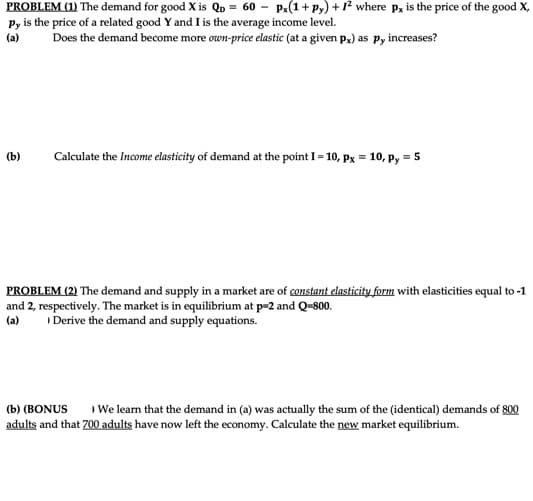PROBLEM (1) The demand for good X is Qp = 60 - Px(1+ Py) +12 where px is the price of the good X, P, is the price of a related good Y and I is the average income level. (a) Does the demand become more own-price elastic (at a given p,) as py increases? (b) Calculate the Income elasticity of demand at the point I- 10, px = 10, py = 5 PROBLEM (2) The demand and supply in a market are of constant elasticity form with elasticities equal to -1 and 2, respectively. The market is in equilibrium at p-2 and Q-800. (a) Derive the demand and supply equations. I We learn that the demand in (a) was actually the sum of the (identical) demands of 800 (b) (BONUS adults and that Z00 adults have now left the economy. Calculate the new market equilibrium.
PROBLEM (1) The demand for good X is Qp = 60 - Px(1+ Py) +12 where px is the price of the good X, P, is the price of a related good Y and I is the average income level. (a) Does the demand become more own-price elastic (at a given p,) as py increases? (b) Calculate the Income elasticity of demand at the point I- 10, px = 10, py = 5 PROBLEM (2) The demand and supply in a market are of constant elasticity form with elasticities equal to -1 and 2, respectively. The market is in equilibrium at p-2 and Q-800. (a) Derive the demand and supply equations. I We learn that the demand in (a) was actually the sum of the (identical) demands of 800 (b) (BONUS adults and that Z00 adults have now left the economy. Calculate the new market equilibrium.
Chapter6: Elasticities
Section: Chapter Questions
Problem 1P
Related questions
Question
a and b only please

Transcribed Image Text:PROBLEM (1) The demand for good X is Qp = 60 - Px(1+ py) + 1? where p, is the price of the good X,
Py is the price of a related good Y and I is the average income level.
(a)
Does the demand become more own-price elastic (at a given p,) as pP, increases?
(b)
Calculate the Income elasticity of demand at the point I = 10, Px = 10, py = 5
PROBLEM (2) The demand and supply in a market are of constant elasticity form with elasticities equal to -1
and 2, respectively. The market is in equilibrium at p=2 and Q-800.
Derive the demand and supply equations.
(a)
(b) (BONUS
We learn that the demand in (a) was actually the sum of the (identical) demands of 800
adults and that 700 adults have now left the economy. Calculate the new market equilibrium.
Expert Solution
This question has been solved!
Explore an expertly crafted, step-by-step solution for a thorough understanding of key concepts.
This is a popular solution!
Trending now
This is a popular solution!
Step by step
Solved in 4 steps

Recommended textbooks for you

Exploring Economics
Economics
ISBN:
9781544336329
Author:
Robert L. Sexton
Publisher:
SAGE Publications, Inc

Principles of Microeconomics (MindTap Course List)
Economics
ISBN:
9781305971493
Author:
N. Gregory Mankiw
Publisher:
Cengage Learning

Essentials of Economics (MindTap Course List)
Economics
ISBN:
9781337091992
Author:
N. Gregory Mankiw
Publisher:
Cengage Learning

Exploring Economics
Economics
ISBN:
9781544336329
Author:
Robert L. Sexton
Publisher:
SAGE Publications, Inc

Principles of Microeconomics (MindTap Course List)
Economics
ISBN:
9781305971493
Author:
N. Gregory Mankiw
Publisher:
Cengage Learning

Essentials of Economics (MindTap Course List)
Economics
ISBN:
9781337091992
Author:
N. Gregory Mankiw
Publisher:
Cengage Learning

Principles of Economics (MindTap Course List)
Economics
ISBN:
9781305585126
Author:
N. Gregory Mankiw
Publisher:
Cengage Learning

Managerial Economics: Applications, Strategies an…
Economics
ISBN:
9781305506381
Author:
James R. McGuigan, R. Charles Moyer, Frederick H.deB. Harris
Publisher:
Cengage Learning
